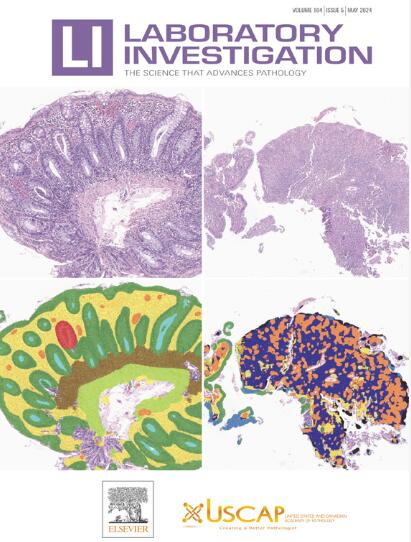Immunoproteomics Reveal Different Characteristics for the Prognostic Markers of Intratumoral-Infiltrating CD3+ T Lymphocytes and Immunoscore in Colorectal Cancer
IF 5.1
2区 医学
Q1 MEDICINE, RESEARCH & EXPERIMENTAL
引用次数: 0
Abstract
Tumor-infiltrating lymphocytes (TILs) and immunoscoring based on densities of CD3+ and CD8+ TILs are both favorable prognostic markers in colorectal cancer (CRC). However, determination of the molecular features of TILs, particularly their immunoproteomic signatures would require the development of large scale in situ spatiotemporal technologies. Recently, a multiplex in situ digital spatial proteomic profiling (DSP) tool GeoMx DSP has been applied to identify biomarkers predictive of therapeutic responses and to understand disease mechanisms and progression. Taking advantage of this tool, we simultaneously characterized the spatial distribution and interactions of 42 immune proteins in tumor cells (TCs), CD3+ T stromal TILs (sTILs), and CD20+ B sTILs using tissue microarrays, and further studied their associations with CD3+ T TILs and immunoscores in CRC. First, our data showed that well-known immune checkpoints, such as PD-L1, PD-L2, and LAG3, were expressed at low levels, whereas some other immune proteins, such as CD11c, CD68, STING, and CD44, were highly expressed. Second, 8 spatial interactions were identified, including 5 interactions between TC and CD20+ B sTILs, 2 interactions between CD3+ T sTILs and CD20+ B sTILs, and 1 interaction among TC, CD3+ T sTILs, and CD20+ B sTILs. Third, the differential immune microlandscape in the spatial compartments was identified in tissues with positive CD3+ T intratumoral TILs and high immunoscores. Collectively, to our knowledge, our study is the first to provide in situ spatial immune characteristics at the proteomic level. Moreover, our findings provide direct evidence supporting the infiltration of CD3+ T sTILs from stoma to TC and shed important insights into better understanding and treating CRC patients related to different immune prognostic markers.
免疫蛋白组学揭示了结直肠癌瘤内浸润 CD3+ T 淋巴细胞和免疫镜检的预后标志物的不同特征。
肿瘤浸润淋巴细胞(TILs)和基于 CD3+ 和 CD8+ TILs 密度的免疫镜检都是结直肠癌(CRC)的有利预后指标。然而,要确定TILs的分子特征,特别是其免疫蛋白组学特征,需要开发大规模的原位时空技术。最近,一种多重原位数字空间蛋白质组剖析(DSP)工具GeoMx DSP已被应用于确定预测治疗反应的生物标记物,并了解疾病的机制和进展。利用这一工具,我们使用组织芯片同时鉴定了肿瘤细胞(TC)、CD3+ T基质TILs(sTILs)和CD20+ B sTILs中42种免疫蛋白的空间分布和相互作用,并进一步研究了它们与CRC中CD3+ T TILs和免疫标志物的关联。首先,我们的数据显示,PD-L1、PD-L2 和 LAG3 等知名免疫检查点的表达水平较低,而 CD11c、CD68、STING 和 CD44 等其他免疫蛋白的表达水平较高。第二,发现了八种空间相互作用,包括五种 TC 与 CD20+ B sTILs 之间的相互作用,两种 CD3+ T sTILs 与 CD20+ B sTILs 之间的相互作用,以及一种 TC、CD3+ T sTILs 和 CD20+ B sTILs 之间的相互作用。第三,在瘤内 CD3+ T TILs 阳性且免疫分数较高的组织中发现了空间分区中不同的免疫微景观。总之,我们的研究首次在蛋白质组水平上提供了原位空间免疫特征。此外,我们的研究结果为 CD3+ T sTILs 从造口向 TC 的浸润提供了直接证据,并为更好地理解和治疗与不同免疫预后标志物相关的 CRC 患者提供了重要启示。
本文章由计算机程序翻译,如有差异,请以英文原文为准。
求助全文
约1分钟内获得全文
求助全文
来源期刊

Laboratory Investigation
医学-病理学
CiteScore
8.30
自引率
0.00%
发文量
125
审稿时长
2 months
期刊介绍:
Laboratory Investigation is an international journal owned by the United States and Canadian Academy of Pathology. Laboratory Investigation offers prompt publication of high-quality original research in all biomedical disciplines relating to the understanding of human disease and the application of new methods to the diagnosis of disease. Both human and experimental studies are welcome.
 求助内容:
求助内容: 应助结果提醒方式:
应助结果提醒方式:


